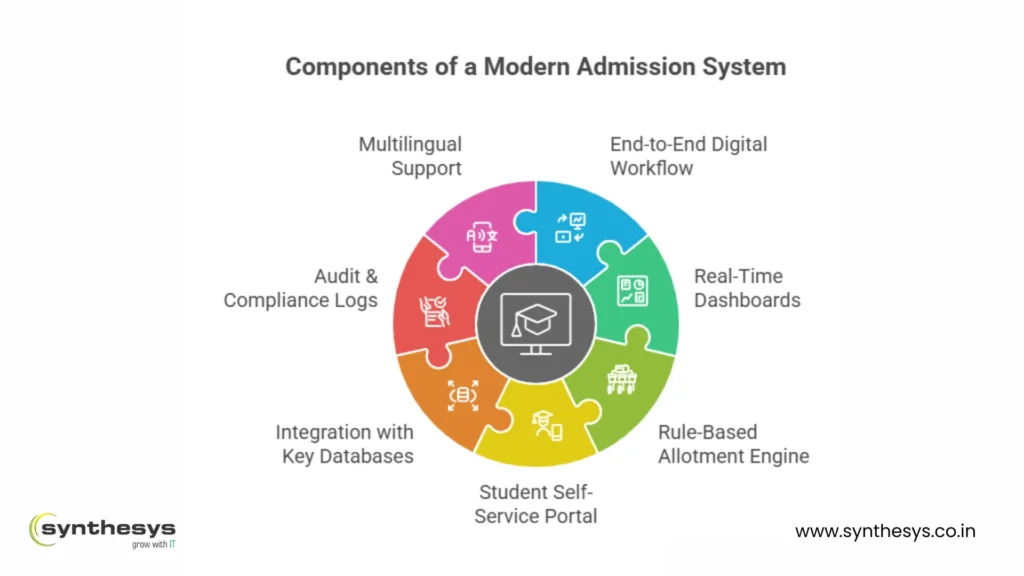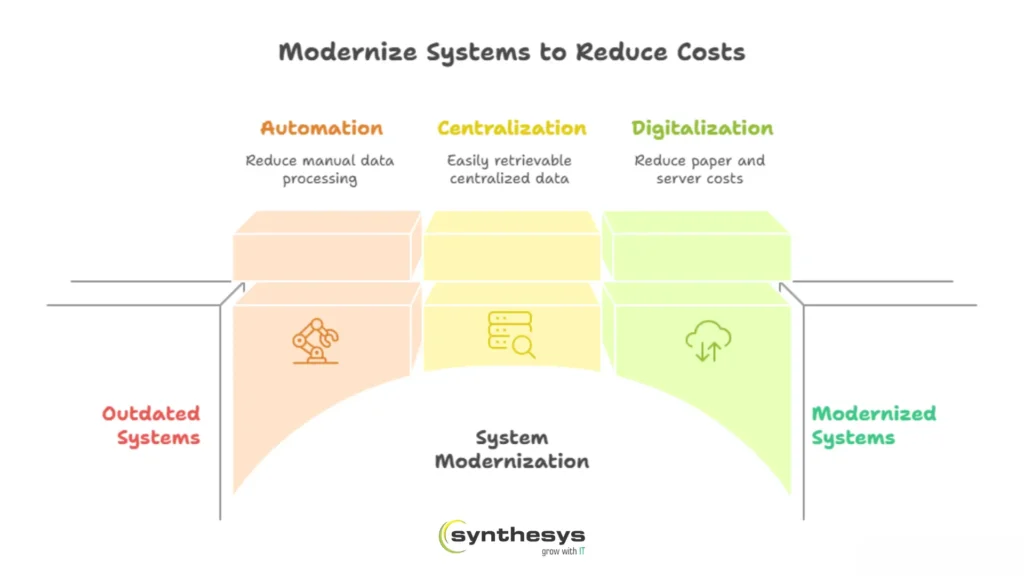If you’re still running student admissions using spreadsheets, forms, or fragmented legacy portals you’re paying more than you realize. Not just in money, but in time, credibility, and missed opportunities.
Government bodies, universities, and educational boards are under mounting pressure to streamline operations. But when it comes to admissions, most institutions still rely on outdated systems that feel more like a patchwork than a process. The result? Longer queues, frustrated parents, overburdened staff, and decision-making based on incomplete data.
Here’s the real problem: these inefficiencies don’t just slow things down they cost you real budget.
Let’s unpack how, why, and what you can do about it.
What’s Still Broken in Most Admission Processes?
Let’s get specific. The typical problems we see across public institutions and higher education bodies during admissions include:
- Manual form handling (offline or semi-online hybrid)
- Delayed merit list processing due to poor data integration
- Duplicate or inaccurate student records
- No real-time seat tracking across colleges or courses
- Poor grievance redressal mechanisms
- Lack of integration with verification bodies (e.g., school boards, ID databases)
These gaps aren’t minor inconveniences. They affect seat allotments, result in admissions errors, and create administrative headaches that cost lakhs in resource hours every year.
Why Traditional Systems Are Costing More Than They Save
Institutions often avoid change because legacy systems are “already paid for” or seem familiar. But maintaining outdated methods comes with hidden and growing expenses.
Here’s where the real costs creep in:
1. Operational Drag = Hidden Manpower Costs
When staff members manually verify, input, and process admission data, they’re pulled away from strategic or student-facing roles. One of our clients a major state education board was using over 300 temporary clerks just to manage college seat allocations during peak admission season. Post-automation? That number dropped by 75%.
2. Error Correction Costs
From misfiled applications to incorrect document uploads, errors in manual systems often go unnoticed until students raise complaints. Rectifying these isn’t free. It takes time, energy, and credibility to fix preventable problems.
3. Compliance and RTI Backlogs
When you don’t have centralized, easily retrievable data, responding to audit requests, RTIs, or policy reviews becomes a fire drill. Traditional systems make traceability difficult leading to missed deadlines and reputational risk.
4. Lost Student Confidence
Every glitch, delay, or miscommunication impacts student and parent trust. In competitive education markets, institutions lose good applicants not because of academics but because the process feels outdated and opaque.
5. Infrastructure Overhead
Local servers, paper storage, manual printing, and courier handling may seem minor but added up across departments and years, they consume significant portions of your admin budget.
Here’s the practical takeaway:
The longer you delay modernization, the more expensive your “free” legacy system becomes.
Why the Admissions Challenge Is Unique in Public Sector Projects
Government-run institutions don’t just process a few hundred applications they handle lakhs of students across hundreds (sometimes thousands) of affiliated institutions.
Some unique challenges in this space include:
- Reservation complexities across categories, regions, and quotas
- Verification dependency on external departments (board results, domicile status, etc.)
- Multi-lingual accessibility
- Multi-phase intake cycles (early admissions, spot rounds, lateral entries)
You can’t just plug in a generic SaaS solution here. You need something tailored for the realities of Indian governance, institutional workflows, and policy mandates.
What a Modern Admission System Looks Like (and What It Solves)
Let’s skip the buzzwords and go straight to what matters. A purpose-built digital admission system for public institutions should offer:
End-to-End Digital Workflow
From application to final seat allotment everything handled in one place.
Real-Time Dashboards for Officials
Track number of applicants, seat status by category, institution-specific insights all updated in real time.
Rule-Based Allotment Engine
Auto-process merit lists using configurable reservation rules, board priorities, and document thresholds.
Student Self-Service Portal
Reduce footfall and frontline pressure by allowing students to apply, track, pay, and download allotment letters online.
Integration with Key Databases
Link with DigiLocker, Aadhaar, education boards, and grievance cells to minimize document fraud and manual verification.
Audit & Compliance Logs
Every change, update, or rejection is tracked. This simplifies RTI responses, reviews, and audit reporting.
Multilingual Support
Essential for equitable access in diverse states.

Example from the Field:
In one state-led pilot, digitizing the undergraduate admission process across 500 colleges cut the average allotment cycle from 21 days to 7 days. Grievances dropped by over 60% within the first year of implementation.
We Want to Modernize but We Can’t Start from Scratch
We hear this a lot. And you’re right.
Many institutions already have some software usually standalone modules built over years. These aren’t always compatible with each other, let alone scalable.
But here’s the key: Modernizing admissions doesn’t have to mean ripping out everything. You can phase it.
Start with:
- Admission front-end (student-facing form + payment + verification)
- Basic admin dashboard
- Merit generation engine
Phase 2:
- Real-time analytics
- Allotment workflows
- Integrations with academic management or ERP modules
Final Layer:
- Policy automation
- Reporting tools
- Predictive analytics for seat planning
Think of it like this: You’re not replacing. You’re evolving. One clean, integrated step at a time.
What Makes an ERP Work in Education Admissions?
ERP systems often fail in education because they’re built like corporate tools rigid, generic, and too complex for non-tech users.
Here’s what actually works in the public education context:
- Modular Design: So you can deploy only what’s needed today
- Workflow Customization: Built to match how institutions actually operate, not how software teams think they should
- User Roles by Hierarchy: District users, institutional heads, helpdesk admins each gets a relevant view
- Offline-Resilient Interfaces: Sync data from low-connectivity zones without friction
- Low-Code Admin Panels: So IT heads can update fields, rules, or notifications without needing a vendor every time
This is exactly where the Synthesys Online Admission System fits in. Designed specifically for Indian public sector education ecosystems, Synthesys balances governance priorities with operational ease. From real-time dashboards and allotment logic engines to multilingual student portals and seamless integrations with board databases everything is engineered for scale, policy alignment, and user adoption. And because it’s modular, institutions can implement it phase-wise without disrupting existing workflows.
The result? Ownership shifts back to the institution, not just the tech partner.
Admission Tech That Respects Governance Complexity
Digitizing a single college’s admission portal is easy. Scaling it to a state-wide admissions authority or technical university? That’s where the real work starts.
Here’s what we’ve learned building and integrating such platforms:
- Policy-first design wins: Always start with admission guidelines, quotas, and reservation rules then build tech around it.
- Training matters: The best system fails if nodal officers and college admins aren’t onboarded properly.
- Feedback loops are critical: Add grievance forms, response deadlines, and escalation matrices right into the system.
- Don’t over-automate: Keep space for manual overrides with logs so you maintain both flexibility and accountability.
This isn’t just software it’s institutional reform, powered by clean design and trustable data.

Looking Ahead: The ROI of Digital Admissions
Let’s simplify the ROI conversation. Here’s what departments and institutions typically see within one admission cycle of going digital:
- 40–60% reduction in processing time
- 50–75% lower temporary staffing costs
- Major drop in document fraud
- Real-time data for policy planning and resource allocation
- Higher student satisfaction ratings and fewer complaints
These are not hypothetical. They’re outcomes from actual deployments in Indian states and universities.
So What’s Stopping Your Institution?
We get it. Change feels risky. There are procurement hurdles, stakeholder resistance, and the ever-present fear of “what if it breaks mid-cycle?”
But here’s the flip side: not changing is now the bigger risk.
Student expectations have changed. Government mandates are evolving. And decision-makers are being held accountable for efficiency, inclusion, and transparency.
You don’t need a giant leap. You just need a clear first step and a partner who knows what they’re doing.
That’s a wrap. If you’re planning a digital transformation project, make sure it starts with clarity, not just code.
What’s the biggest roadblock you’ve faced in implementing digital admissions? Let us know or start a conversation with us directly.
